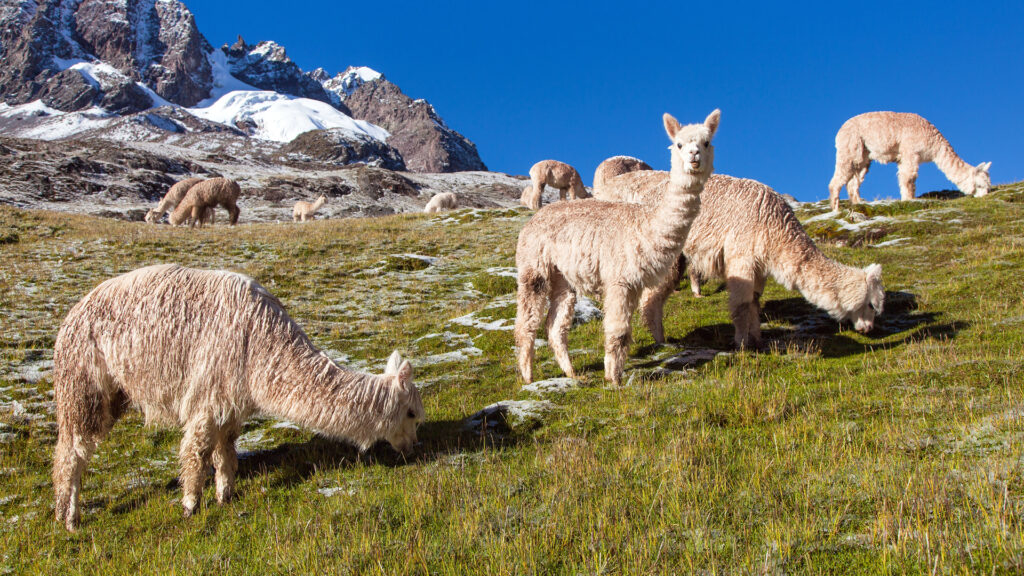When a glacier melts, all it leaves in its wake is untouched ground. These craggy, lifeless rocks begin to feel sun and rain for the first time in millennia. They contain a few seeds, perhaps, stored in the freezing embrace of the glacier above them. But when the first rains touch their surface, most of what washes from the ground is poison.
The rocky soils uncovered by melting glaciers send acidic water into the communities downstream. Over time, the plants and soils of a well-developed ecosystem will trap these harmful chemicals like a filter. But that can take decades, because such isolated high-altitude ecosystems recover extremely slowly once a glacier retreats.
To speed up this natural protection in the face of climate change, scientists have joined with residents in the Cordillera Blanca, Peru, to enlist their famously fuzzy agricultural helper: the llama (Llama glama).
After bringing llamas back to these exposed lands to graze, scientists saw dramatic improvements in the quality of the soil and the health of the recovering ecosystem in just three years. Not only did the llamas fertilize the soil, but they also brought new seeds to the land, according to a recent paper in Scientific Reports.
“I did not expect it to have significant changes in plant cover and soil composition in three years. It’s pretty fast,” said environmental scientist Anaïs Zimmer of the University of Texas at Austin, the study’s lead author. Three of Zimmer’s five colleagues on the project live and work in Peru.

Llamas, bred from the wild vicuña, are culturally important in Peru. They provide labor, wool, food, fuel and fertilizer to the mountain residents who have herded them for 6,000 years. The animals are light enough that they can tamp seeds into the soil without trampling them. They disperse seeds with their fur and hooves — and even their dung, the research team showed.
The soil enhancements brought by the llamas are vital to help prevent one of the largest direct impacts of glacial retreat: acid rock drainage. Acids, heavy metals and other contaminants previously locked away under the glacier get washed down into water bodies, food supplies, and farms. The Uruashraju glacier on the study site lost about half of its length from 1948 to 1990. All of that lost water carried acid downstream into farms and villages.
To understand how llamas might help this barren post-glacial ecosystem, Zimmer and her team sectioned off eight plots of land in the shadow of the glacier, almost 5,000 meters (16,400 feet) above sea level. In half of these plots, the researchers brought herds of three llamas to graze the land for three days each month. The other four plots were left ungrazed. The team measured the variety of plants and their health, as well as the composition of the soil, to understand how the newly exposed ecosystem changed over time.
Every time llamas visited from the more diversely vegetated lowland, they brought fertilizer in the form of their dung, rich with nitrogen and organic carbon. Once spread on the barren landscape, the dung improved soil health and helped plants grow faster. The llamas also brought seeds, which scattered among the llama plots and sprouted into far more plants than in the test plots.
“They took an experimental approach, and they essentially manipulated primary succession,” the first steps for organisms to recolonize a barren area of land, said ecologist Kelsey Reider of James Madison University in Harrisonburg, Virginia, who was not associated with the study. “I don’t know of any other instance where people have actually taken an experimental approach to doing that.”
The Llama 2000 Asociación, a group of Peruvian farmers founded to restore the cultural practice of llama herding through tourism, had suffered as more glaciers melted and the COVID-19 pandemic affected the region. The association worked with Zimmer’s research team to provide the animals and the expertise needed to bring the native herbivores back to the remote landscape.
“The project helps us develop our knowledge regarding the preservation of plant resources, and it motivates us to continue learning management techniques” as the climate changes, said Jorge Martel, a mentor within the Llama 2000 Asociación, in a message to Mongabay.
Zimmer looks forward to her team’s ongoing ties with Peruvians — and their animal companions — who are coping day-to-day with the impacts of melting glaciers. “The research question was just super exciting,” she said. “It was very interesting to try to answer a local need in collaboration with the local population.”
Sierra Bouchér is a graduate student in the Science Communication Program at the University of California, Santa Cruz. Other Mongabay stories produced by UCSC students can be found here. This piece was originally published at https://news.mongabay.com/2023/11/llama-herding-helps-community-in-peru-recover-from-a-melting-glacier/.
Sign up for The Invading Sea newsletter by visiting here. If you are interested in submitting an opinion piece to The Invading Sea, email Editor Nathan Crabbe at ncrabbe@fau.edu.



